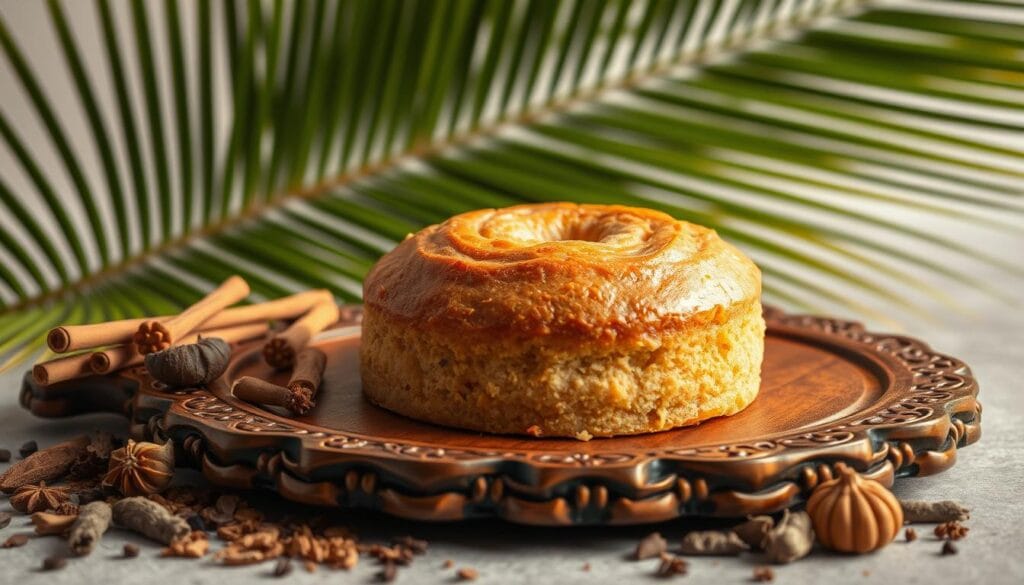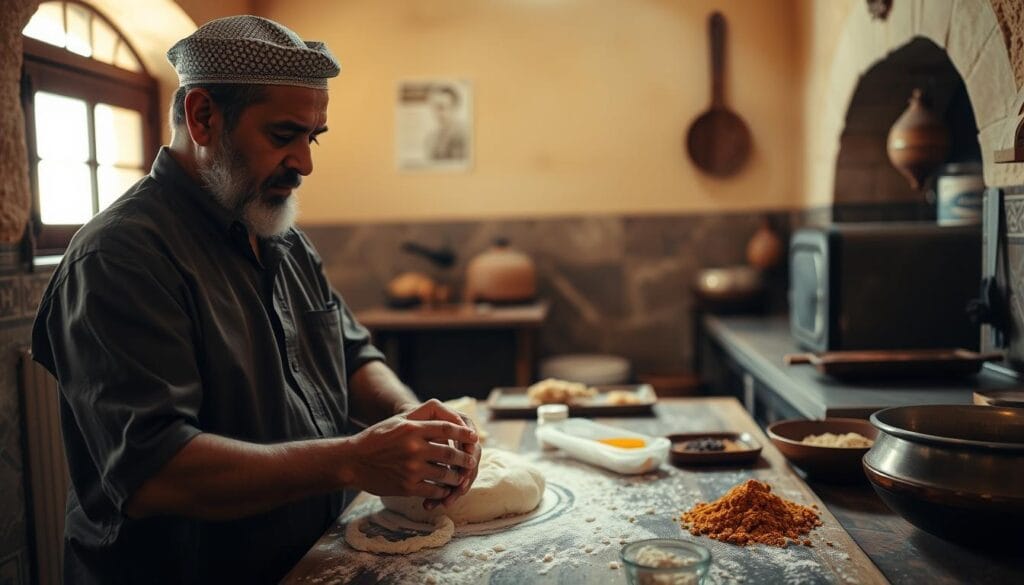Savor the Flavors of Ahmed Al-Zamel’s Renowned Cake
Imagine walking into a cozy kitchen filled with the sweet smell of a traditional Kuwaiti dessert. Ahmed Al-Zamel’s cake is more than just a treat. It’s a journey through generations of Middle Eastern baking.
This Kuwaiti dessert is not just about ingredients. It’s about a rich cultural heritage that brings families together. It celebrates centuries of cooking expertise.
When you try Ahmed Al-Zamil’s recipe, you’ll see why it’s loved in Middle Eastern cuisine. Each bite is a taste of Kuwait’s lively food scene. The cake is a perfect mix of skill, tradition, and love.
Table of Contents
Key Takeaways
- Ahmed Al-Zamel’s cake represents authentic Kuwaiti culinary traditions
- The dessert offers a unique sensory experience beyond typical sweet treats
- Each recipe tells a story of cultural heritage and family history
- Traditional baking methods contribute to the cake’s distinctive flavor profile
- The cake serves as a cultural ambassador of Kuwaiti dessert craftsmanship
The Rich Heritage Behind Ahmed Al-Zamel’s
Explore the world of traditional sweets in Kuwait. Ahmed Al-Zamel’s is more than a dessert. It showcases the vibrant Arabic pastries that comprise Khaleej cuisine.

Origins in Traditional Kuwaiti Baking
The story of this cake starts in Kuwait’s kitchens. Bakers for generations have kept their techniques alive. They turn simple ingredients into amazing desserts, showing the region’s deep culinary history.
- Passed down through family generations
- Rooted in authentic Kuwaiti baking methods
- Represents cultural culinary traditions
Family Legacy and Recipe Evolution
Each recipe has a family story. The Al-Zamel family has kept their baking techniques alive. Their arabic pastries are more than food; they’re memories.
| Generation | Key Recipe Contribution |
|---|---|
| First Generation | Original recipe development |
| Second Generation | Ingredient refinement |
| Current Generation | Modern presentation techniques |
Cultural Significance in Middle Eastern Desserts
In khaleeji cuisine, this cake is more than food. It’s about hospitality, celebration, and connection. Ahmed Al-Zamel’s cake is a symbol of Middle Eastern warmth and generosity.
“A slice of cake is a slice of cultural heritage” – Kuwaiti Culinary Proverb
Essential Ingredients That Make This Cake Special

Making authentic Middle Eastern treats needs a good grasp of picking the right ingredients. Ahmed Al-Zamel’s cake is special because of its chosen ingredients. They turn simple parts into a true work of art.
The secret of these semolina cakes is in their top-notch ingredients. It’s key to use the best ingredients to achieve the unique flavor that Middle Eastern sweets are known for.
- Premium semolina flour: Provides a unique, grainy texture
- Fresh dates: Brings natural sweetness and depth
- Clarified butter (ghee): Enhances richness and flavor
- Aromatic spices: Creates complex taste dimensions
Date-filled cakes need top-quality ingredients. Each part is important for the cake’s special taste and feel.
| Ingredient | Purpose | Flavor Impact |
|---|---|---|
| Semolina | Base flour | Nutty, robust texture |
| Dates | Natural sweetener | Caramel-like richness |
| Rose Water | Aromatic enhancer | Delicate floral notes |
Knowing how each ingredient works makes a simple recipe into something amazing. You’ll grow to love these Middle Eastern sweets more as you see how each flavor works together.
The Art of Preparing Ahmed Al-Zamel’s Signature Recipe
Making an authentic ahmed al-zamel’s cake needs precision, passion, and respect for Kuwaiti desserts. It’s a culinary masterpiece that requires careful attention and traditional methods passed down through generations.

The journey of making this dessert starts with understanding its detailed preparation. Each step shows the rich cultural heritage of Kuwaiti baking traditions.
Traditional Mixing Techniques
Learn the art of mixing with these essential steps:
- Sift dry ingredients carefully to ensure smooth texture
- Blend wet ingredients at room temperature
- Use gentle folding motions to maintain air pockets
- Mix ingredients in a specific sequence for optimal flavor
Temperature and Timing Secrets
When preparing ahmed al-zamel’s cake, precision is key. Temperature control is crucial:
- Preheat oven to exact specifications
- Use an accurate kitchen thermometer
- Allow ingredients to reach room temperature
- Monitor baking time meticulously
“Baking is an art where science meets passion” – Traditional Kuwaiti Baker
Authentic Baking Methods
Use traditional baking techniques that have been perfected over decades. The secret is understanding the balance of ingredients and mastering the baking process.
Pro tip: Patience and attention to detail are your greatest allies in creating a perfect ahmed al-zamel’s cake.
Distinctive Flavors and Aromatic Components
Ahmed Al-Zamel’s cake is a true marvel. It combines rose water flavors and saffron aromas in a way that’s truly special. This mix turns a simple dessert into a feast for the senses, taking you straight to the heart of Middle Eastern cooking.
Saffron is key to the cake’s unique taste. This rare spice gives it a golden color and a warm, exotic flavor. The saffron’s delicate threads add subtle notes that tickle your taste buds.
- Rose water flavors bring a fragrant elegance to each bite
- Saffron provides rich, complex undertones
- The combination creates a harmonious taste experience
When you take a bite, you’ll find a perfect balance of flavors. The rose water adds a soft sweetness, while the saffron adds depth and class. This blend shows the skill and tradition of Ahmed Al-Zamel’s family recipe.
“A single bite reveals centuries of gastronomic tradition”
Understanding these flavors lets you see the artistry behind the cake. Each ingredient is chosen with care, making for a journey that celebrates Middle Eastern baking.
The Perfect Balance of Middle Eastern Spices
Exploring traditional sweets opens a world of flavors. Spices turn simple desserts into amazing treats. Arabic pastries are famous for their special spice mixes that delight your taste buds.
Spice blending in Middle Eastern cooking is a tradition that’s been passed down for ages. Each spice adds to the flavor, making the dessert even better.
Saffron’s Golden Touch
Saffron is the most valuable spice in Middle Eastern cooking. It adds a golden color and a hint of earthiness to sweets. Its special threads make ordinary pastries into something truly special.
- Harvested by hand from crocus flowers
- Provides a distinctive amber color
- Offers a nuanced, slightly sweet flavor
Rose Water Integration
Rose water is key in making real Middle Eastern desserts. Its light floral scent adds depth to the taste. It makes every bite a delight.
Traditional Spice Combinations
Skilled bakers mix spices to create perfect flavors. The best mixes include:
- Cardamom
- Cinnamon
- Nutmeg
- Cloves
These spices blend to create a flavor that excites your senses. It takes you straight to the heart of Middle Eastern cooking.
Texture and Presentation Mastery
Making perfect middle eastern confections is a big challenge, especially with semolina cakes. Ahmed Al-Zamel’s cake is famous for its unique texture and beauty.
The special texture of these cakes comes from the right ingredients and careful making. Semolina flour is key for a soft yet slightly crunchy feel. This makes these desserts stand out in the Middle East.
- Achieve a golden-brown exterior with delicate crumbly interior
- Balance moisture and density for optimal texture
- Create layers of flavor through strategic ingredient integration
Presenting these desserts is like an art. The cake is cut into neat shapes, showing off its inside beauty.
| Presentation Element | Technique |
|---|---|
| Cutting Style | Diamond or rhombus-shaped slices |
| Garnishing | Dusted pistachios, edible rose petals |
| Serving Temperature | Slightly warm or room temperature |
Professional bakers know that looks matter. They turn semolina cakes into true works of art. Each slice shares a story of tradition, skill, and culture.
Modern Adaptations of the Classic Recipe
Ahmed Al-Zamel’s traditional Kuwaiti desserts have evolved. They now meet today’s culinary needs while keeping their authentic roots. The classic date-filled cakes have adopted new techniques that attract modern food lovers.
Chefs and home bakers are making the traditional recipe their own. They do this by adding their own creative twists while staying true to its cultural heritage. This way, beloved Kuwaiti desserts stay fresh and exciting for the next generation.
Contemporary Flavor Explorations
- Infusing international flavor profiles like lavender and cardamom
- Creating fusion date-filled cakes with chocolate and nuts
- Experimenting with alternative presentation styles
Dietary Modifications
Bakers are now making desserts for everyone. They create versions that fit different dietary needs:
- Gluten-free adaptations using alternative flour blends
- Vegan recipes replacing traditional dairy ingredients
- Low-sugar options for health-conscious dessert lovers
“Tradition meets innovation in every delectable bite” – Kuwait Culinary Association
These new takes on date-filled cakes are a hit. They bring joy to our taste buds while celebrating their cultural importance.
Serving Suggestions and Pairings
Exploring khaleeji cuisine is more than just eating. It’s about enjoying a complete sensory journey. Ahmed Al-Zamel’s signature cake is a key part of this experience.
When you serve this cake, consider these pairing tips:
- Arabic Coffee: A classic that brings out the cake’s rich flavors
- Cardamom Tea: It complements the cake’s delicate spices
- Fresh Dates: They add natural sweetness and balance the cake’s texture
For a modern twist, try new ways to serve the cake. Use elegant ceramic platters or garnish with pistachios and edible rose petals. These presentation ideas turn the dessert into a stunning centerpiece.
At family gatherings or formal events, Ahmed Al-Zamel’s cake is a great conversation starter. Its complex flavors and cultural importance make it more than a dessert. It’s a symbol of rich khaleeji cuisine heritage.
“A slice of tradition, served with love and care” – Culinary Experts
Storage Tips and Freshness Duration
Keeping ahmed al-zamel’s cake fresh is key. Arabic pastries need special care to keep their taste and texture perfect.
Storing your arabic pastries right is essential. Here are some tips to keep your cake fresh and tasty.
Short-Term Storage Strategies
- Store at room temperature in an airtight container
- Keep away from direct sunlight and heat sources
- Use a cake dome or sealed plastic container
- Consume within 2-3 days for optimal taste
Refrigeration Recommendations
For longer storage, refrigeration is a good choice. Wrap the cake carefully in plastic wrap or aluminum foil before placing in the refrigerator.
- Refrigerate for up to 5-7 days
- Allow cake to reach room temperature before serving
- Avoid storing near strong-smelling foods
“The secret to maintaining the cake’s delicate flavor is in its careful storage” – Baking Experts
Freezing for Extended Preservation
Freezing is great for longer storage. Wrap individual slices or the entire cake in multiple layers of plastic wrap and aluminum foil.
- Freeze for up to 3 months
- Thaw overnight in the refrigerator
- Bring to room temperature before serving
By using these storage tips, your ahmed al-zamel’s cake will stay delicious for a long time.
Where to Find Authentic Ahmed Al-Zamel’s Cake
Finding the perfect Ahmed Al-Zamel’s cake is a journey. It starts with knowing where to find authentic Kuwaiti desserts. These places capture the true essence of Middle Eastern confections.
In Kuwait, you’ll find several bakeries famous for this treat:
- Al-Yasmin Bakery in Kuwait City
- Traditional Sweets Boutique in Salmiya
- Royal Kuwaiti Confectionery in Hawalli
For those outside Kuwait, online shopping makes it easy to get these treats. Websites and stores that import gourmet foods now ship Kuwaiti desserts worldwide.
When looking for real Ahmed Al-Zamel’s cake, watch for these signs:
- Choose bakeries with years of family baking
- Look for traditional baking methods
- Make sure ingredients come from the Middle East
- Read reviews from people who love Middle Eastern food
Pro tip: Talk to local Middle Eastern groups or cultural centers. They know the best places for traditional desserts and can give great tips.
“The true flavor of Kuwait is found in its carefully crafted desserts” – Kuwaiti Culinary Association
Whether you’re in Kuwait or far away, Ahmed Al-Zamel’s cake is now easy to find. Dive into the rich tradition of these amazing Middle Eastern sweets.
Conclusion
Ahmed Al-Zamel’s cake is more than a tasty treat. It’s a story of Kuwaiti culinary tradition. You’ve seen how it combines flavor, technique, and cultural importance. This cake shows the heart of Middle Eastern food.
This cake connects us to our past and keeps our culture alive. The mix of spices and the family recipes make it special. It’s a treasure for food lovers and those curious about Kuwaiti cuisine.
Trying Ahmed Al-Zamel’s cake is a chance to taste something unique. You can find it in local bakeries or make it at home. Each bite shares a piece of tradition and Middle Eastern spirit.
Thinking about Ahmed Al-Zamel’s cake reminds us of food’s power. It connects us, our memories, and cultures. This cake is a delicious way to keep traditions alive and build connections.
FAQ
What makes Ahmed Al-Zamel’s cake unique in Kuwaiti cuisine?
Are there any special ingredients in this traditional cake?
How is Ahmed Al-Zamel’s cake typically served?
Can the cake be adapted for special dietary requirements?
How long can Ahmed Al-Zamel’s cake be stored?
Is this cake only available in Kuwait?
What is the significance of the cake in Kuwaiti culture?
How challenging is it to make this cake at home?
How Was It?
There are no reviews yet. Be the first one to write one.

